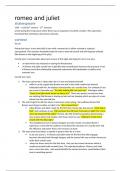Samenvatting
Summary GCSE English Literature Romeo and Juliet
- Vak
- Instelling
- Boek
More than 10 quotes for each character / theme Context on Elizabeth England Context on Shakespeare Context on sin, gender, astronomy, plays, religion and love Description of Freytag’s pyramid Includes all allusions in Romeo and Juliet Includes high level vocabulary describing the char...
[Meer zien]














